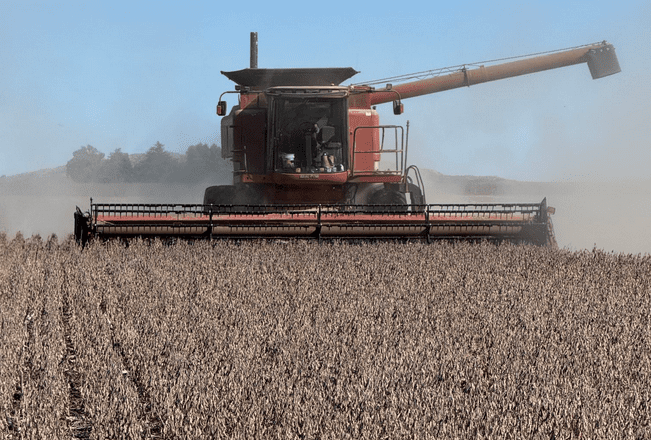
Harvesting soybeans in Argentina ealier this month. Photo: @PecoAz
ARGENTINA’S exporters signed a letter of intent with China last week to ship around US$900 million worth of soybeans, corn and vegetable oil to China, adding momentum to Beijing’s attempts to skirt the United States as a source of key agricultural produce.
The non-binding agreement was reportedly signed in Buenos Aires last Wednesday in a meeting between Argentinian officials managing international trade and agricultural markets and a delegation from the China Council for the Promotion of International Trade.
While not unique, such a significant upfront commitment by China for Argentina’s main agricultural exports is considered rare. Its signing amid a rapidly escalating trade war may indicate that Beijing is preparing to maintain tariffs, or at the very least improve its bargaining position, on US agricultural imports by securing the supply of key commodities from alternate exporters such as Argentina.
Argentina is the world’s top supplier of soybean meal and soybean oil, and China is already the biggest destination for the nation’s raw soybean exports. The Asian powerhouse also buys small quantities of soybean oil and, last year, opened its doors to Argentina’s corn exports. While no shipments of soybeans have been executed since January, and corn shipments remain zero in 2025, that is certainly expected to change as new-crop supplies hit the market.
IMF currency role
This new deal follows the renewal last month of a multi-billion dollar currency swap agreement between Argentina and China, despite Washington’s fierce opposition to the transaction. Set to wind down in June, cash-strapped Argentina agreed to extend the $5-billion accord with Beijing for another year, securing much-needed foreign currency reserves.
Argentina has struggled to get enough foreign currency to pay down international debt while keeping its own currency, the peso, stable. The move would significantly boost Argentina’s international reserves, which have been dwindling in recent months as the central bank sells dollars to prop up the peso. The deal gives Argentina access to more Chinese yuan, one of five currencies that can be used to repay debts with the International Monetary Fund, in return for China gaining pesos and significant influence in the region, especially as a lender of last resort.
Then, hot on the heels of the currency-swap pact, came news that the Executive Board at the IMF had approved a 48-month Extended Fund Facility arrangement for Argentina totalling $20B, despite the Trump administration’s threat to withhold support for the funding if the China swap deal was renewed. Already the IMF’s largest debtor by far, the financing arrangement came with an immediate disbursement of $12B and a first review planned for June 2025 with an associated disbursement of around $2B.
The new arrangement follows a request by the Argentine authorities for medium-term balance of payments assistance to support the next phase of President Javier Milei’s stabilisation and reform agenda. The program is expected to activate further official financing from multilateral sources, notably from the World Bank Group and the Inter-American Development Bank, and seeks to facilitate a timely return to international capital markets.
Clinching the IMF deal last month then became the catalyst for President Milei to lift most of the country’s strict capital and currency controls from April 14. In a high-stakes gamble, Argentina’s central bank undid its fixed-currency peg, letting the peso fluctuate freely against the US dollar, within a band of 1000-1400 pesos per US dollar against 1074 immediately prior to the float.
Argentina will eliminate major parts of the so-called “cepo” capital controls imposed in 2019. The tangle of regulations designed to stabilise the peso at an official rate and prevent capital flight from Argentina have severely restricted the country’s access to foreign currency. Companies will also be permitted to repatriate profits out of the country, a key demand from businesses that could unlock more foreign investment.
Floating the peso reignited concern that inflation, which had been decreasing under President Milei’s tough austerity measures, would accelerate again. However, with the government reinforcing its plans for a fiscal surplus, pledges not to intervene in the foreign exchange market until the peso strengthens, an inflow of US dollars from grain exports, as well as tight domestic monetary conditions, the currency has strengthened and allayed those inflation fears.
Argentine crop improves
Meanwhile, the Buenos Aires Grain Exchange has increased its soybean production estimate for the 2024-25 season by 1.4 million tonnes (Mt) to 50Mt on the back of better-than-expected harvest yields. This aligns with respected row-crop analyst Michael Cordonnier, who has a neutral to higher bias on his 50Mt estimate. The latest global balance sheet from the United States Department of Agriculture has Argentina pencilled in for 49Mt.
Harvest of the 18.4M-hectare crop made significant progress in the week to May 7, up 21 percentage points to 44.9 percent completed, but still lagging the long-term average by around 25 percentage points. The average yield across all harvested fields, both first and second crop, currently stands at 3.24t/ha compared to the final 2023-24 average of 2.97t/ha.
However, with 53pc of first crop soybeans harvested, the average yield sits slightly higher at 3.33t/ha. Results surpass initial expectations, particularly in Córdoba and the Central-Eastern areas of Entre Ríos, confirming the upward trend anticipated in recent weeks. The second crop soybean area is 21pc harvested, and early results also show higher-than-expected yields.
Last week’s corn production estimate from the Buenos Aires Grain Exchange was unchanged at 49Mt, against an average of the past five seasons of 50Mt. Again, this aligns with Dr Cordonnier’s most recent update, and he maintains his neutral to higher bias. The USDA’s current production forecast is marginally higher at 50Mt.
Harvest operations progressed well ahead of increased rainfall activity at the back end of last week. As of May 7, 34.9pc of the 7.1 million planted corn hectares had been reaped, with the yield averaging 8.18t/ha. The cumulative harvest volume of 20.1Mt is 4.9Mt ahead of the same date in 2024, primarily driven by a higher proportion of early plantings.

HAVE YOUR SAY